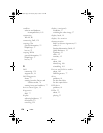
172 Glossary
Strike Zone™ — Reinforced area of the platform base that protects the hard drive by
acting as a dampening device when a computer experiences resonating shock or is
dropped (whether the computer is on or off).
surge protectors — Prevent voltage spikes, such as those that may occur during an
electrical storm, from entering the computer through the electrical outlet. Surge
protectors do not protect against lightning strikes or against brownouts, which occur
when the voltage drops more than 20 percent below the normal AC-line voltage level.
Network connections cannot be protected by surge protectors. Always disconnect the
network cable from the network connector during electrical storms.
SVGA — super-video graphics array — A video standard for video cards and
controllers. Typical SVGA resolutions are 800 x 600 and 1024 x 768.
The number of colors and resolution that a program displays depends on the
capabilities of the monitor, the video controller and its drivers, and the amount of
video memory installed in the computer.
S-video TV-out — A connector used to attach a TV or digital audio device to the
computer.
SXGA — super-extended graphics array — A video standard for video cards and
controllers that supports resolutions up to 1280 x 1024.
SXGA+ — super-extended graphics array plus — A video standard for video cards and
controllers that supports resolutions up to 1400 x 1050.
system board — The main circuit board in your computer. Also known as the
motherboard.
system setup — A utility that serves as an interface between the computer hardware
and the operating system. System setup allows you to configure user-selectable options
in the BIOS, such as date and time or system password. Unless you understand what
effect the settings have on the computer, do not change the settings for this program.
system tray — See notification area.
T
TAPI — telephony application programming interface — Enables Windows programs
to operate with a wide variety of telephony devices, including voice, data, fax, and
video.
text editor — A program used to create and edit files that contain only text; for
example, Windows Notepad uses a text editor. Text editors do not usually provide
word wrap or formatting functionality (the option to underline, change fonts, and
so on).
book.book Page 172 Tuesday, July 3, 2007 12:31 PM


















